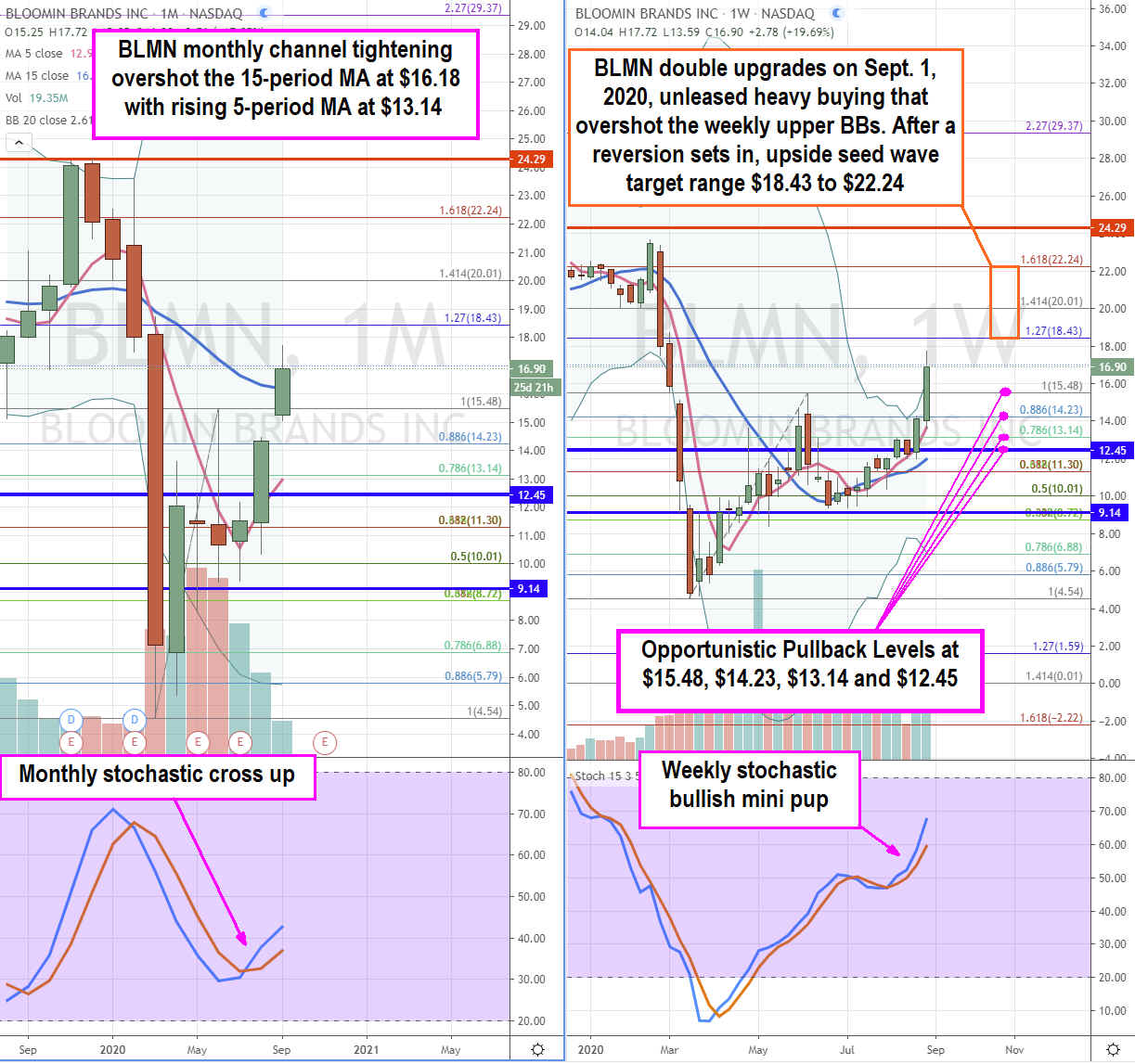Shares of global restaurant operator Bloomin' Brands NASDAQ: BLMN have recently surged as the pandemic recovery narrative finds its way into beaten-down restaurant stocks. Despite the gains, shares are still trading below its pre-COVID levels temporarily causing it to move inversely with the benchmark S&P 500 index NYSEARCA: SPY. As pandemic winners recede, money flow is spreading out to consumer discretionary as portfolio rebalancing takes effect. While the migration of fast-casual restaurants to off-site distribution channels has bolstered recovery effects, the predominantly dine-in players are still lagging. Prudent investors looking to take part in the restart and experiential recovery narrative in one of the worst-hit industries may want to consider opportunistic pullback entries on Bloomin’ Brands.
Q2 FY 2020 Earnings Release
On July 20, 2020, Bloomin’ Brands released its second-quarter fiscal 2020 results for the quarter ending June 2020. The Company reported a loss of (-$0.74) per share excluding non-recurring items versus consensus analyst estimates for a loss of (-$1.17) per share, a $0.43 per share beat. Revenues fell (-43.4%) year-over-year (YoY) to $578.5 million, falling short of consensus estimates of $591.05 million. The Company had announced 928 its company-owned restaurants were operational as of July 19, 2020. This represents 92% of U.S. restaurants. Its largest chain Outback Steakhouse had 527 locations open and operating at up to 50% capacity as mandated by phase-in capacity mandates. Sales have been sequentially improving generating positive cash flow in the month of June.
Conference Call Takeaways
On the Q2 conference call, CEO Dave Deno, credited its rapid reopening success to not laying off or furloughing any employees during the pandemic and having them at the ready to redeploy. This operational efficiency enabled its Outback Steakhouse restaurants to quickly recover sales to just a (-10.7%) drop in YoY revenues for the week ending July 19, 2020. The Company is also maintaining high off-premise mix of sales for delivery and to-go, which is a go-forward strategy. Over 70% of locations are offering limited in-restaurant dining. Sales have improved from down (-50%) in April to down only (-17%) to (-19%) range YoY in the U.S. Bloomin Brands ended the quarter with $502 million in liquidity including $138 million in cash and $364 million revolver. The Company won’t be providing forward guidance or interim financial updates before its Q3 2020 earnings release scheduled in November 2020. During the Q&A session, the Company noted that demand is exceeding seat capacity and they have been able to retain the same elevated levels of off-premise sales even as in-restaurant dining continues to expand.
CNBC Interview
Bloomin’ Brands CEO Deno was interviewed on CNBC July 24, 2020. Deno stated that pandemic hotspots Florida and Texas have maintained improving sales trends despite the surge in COVID-19 cases. Outback Steakhouse continues to improve sales trends sequentially. To-go and delivery business peaked at 3X historical average. The Company has not experienced any food inflation during the pandemic.
Analyst Upgrades
Bloomin’ Brands has steadily been receiving analyst upgrades since its Q2 2020 earnings release. JP Morgan Chase upgraded shares to overweight on July 27, 2020. On Sept. 1, 2020, Deutsche Bank upgraded shares to a buy rating with a $20 per share target. On that same day, Raymond James upgraded Bloomin’ Brands stock to a strong buy with an $18 per share price target. These double upgrades caused shares to overextend its surge through the weekly upper Bollinger Bands (BBs). Prudent investors will want to wait for opportunistic pullback entries as reversion kicks in. 
BLMN Stock Trajectory Levels
Using the rifle charts on the monthly and weekly time frames provides a broader view of the landscape for BLMN stock. The monthly rifle chart triggered a market structure low (MSL) buy above the $12.45. The monthly rifle chart also completed its channel tightening with a bullish stochastic mini pup to and through the 15-period moving average (MA) at $16.18. The weekly rifle chart has a stochastic mini pup that overshot the upper BBs at $16.18. Additionally, the weekly has a seed wave pattern which provides three upside potential reversal zones (PRZs) based on Fibonacci (fib) level extensions. The upside targets are $18.43, $20.01 and $22.24 respectively. A pullback is expected under the weekly upper BBs which happen to also overlap with the monthly 15-period MA at $16.18. If the BLMN slips back under there, then keep an eye out for opportunistic pullback levels at $15.48 fib, $14.23 fib, $13.14 fib and $12.45 monthly MSL trigger. Nimble traders can scalp off the fibs and keep an eye on other peer stocks like the higher-end steak house Ruth’s Hospitality Group NASDAQ: RUTH and Darden Restaurants NYSE: DRI operator of competitor Longhorn Steakhouse. Longer-term investors and swing traders will find it most prudent to consider using the pullbacks to scale in pyramid fashion and keep trail stops according to risk tolerance levels.
Before you consider Bloomin' Brands, you'll want to hear this.
MarketBeat keeps track of Wall Street's top-rated and best performing research analysts and the stocks they recommend to their clients on a daily basis. MarketBeat has identified the five stocks that top analysts are quietly whispering to their clients to buy now before the broader market catches on... and Bloomin' Brands wasn't on the list.
While Bloomin' Brands currently has a Reduce rating among analysts, top-rated analysts believe these five stocks are better buys.
View The Five Stocks Here
If a company's CEO, COO, and CFO were all selling shares of their stock, would you want to know? MarketBeat just compiled its list of the twelve stocks that corporate insiders are abandoning. Complete the form below to see which companies made the list.
Get This Free Report
Like this article? Share it with a colleague.
Link copied to clipboard.